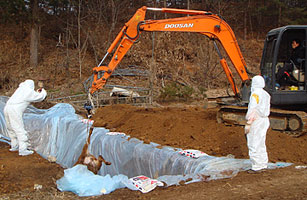
Shin Chang-seon seems to know everyone in Gapyeong, a small town about 45 miles northeast of Seoul. The 58-year-old president of the local beef association was once the village chief here; he now has a cattle farm with just over 100 cows. As he walks around town, residents approach him on the street to shake his hand and talk about local issues.
But in farming-heavy Gapyeong , the conversation has shifted from countryside small talk to concern and shock over foot-and-mouth disease, a deadly virus to all cloven-footed animals. Since South Korea’s recent outbreak took hold in late November, foot-and-mouth has been confirmed on 118 farms across the country and has led to the slaughter of close to 1.7 million farm animals.
Now, Shin, whose own cows have not been infected, makes regular phone calls to console farmers in the area who have had their cows slaughtered by government teams sent out around the nation to try to stop the spread of the disease. Unable to do anything, farmers watch their animals and livelihood die before their eyes. “It’s unbelievable to see what’s happening,” Shin says. “We have built these farms, in my case, for over 30 years. And that could all be shattered overnight.”
Things could get worse. As of Jan. 11, cloven-footed animals on 3,500 farms within a certain distance of the confirmed cases have been slaughtered, according to the Ministry for Food, Agriculture, Forestry and Fisheries, and the disease is still spreading. The methods have been rough on farmers and distant viewers alike: in the hurry to contain the disease, more than 1 million pigs have been culled, many buried alive because euthanasia drugs have run out. The activity has earned the Korean government ire from animal-rights groups like PETA, which stated on its website that people should “urge South Korean authorities to stop this massacre immediately.” An official at the Agriculture Ministry told the daily Kyunghyang Sinmun that the government has temporarily run out of euthanasia drugs but is trying to find other humane ways to cull them.
Meanwhile, the National Veterinary Research and Quarantine Service, an arm of the Agriculture Ministry, has been vaccinating cows and pigs all across South Korea in a bid to rid the country of the virus. Lee Byoung-guan, an official at the quarantine service, says the government has vaccinated roughly 1,450,000 pigs, cows, deer, goats and sheep and will continue to do so until every farm animal in the country is vaccinated — though the ministry says it will first focus its vaccination efforts on areas hit hardest by foot-and-mouth. “We work day and night,” Lee says. “If there’s a report [of foot-and-mouth], we go right away and confirm the case.”
According to the Agriculture Ministry, the mass cull has caused wholesale prices of beef and pork to rise in January: 9% and 22% over December’s average prices, respectively. Imports have also risen, to make up for losses in domestic supply. South Korea is a net importer of beef, chicken and pork, getting most of its pork from the United States and most of its beef from Australia.
There have also been reports that the disease has spread to North Korea, where, according to Yonhap News Agency, the North’s military has been trying to stop the spread of the disease by disinfecting farms around the country. The JoongAng Ilbo, citing an intelligence official, said the disease could take a toll on the country’s food supply.